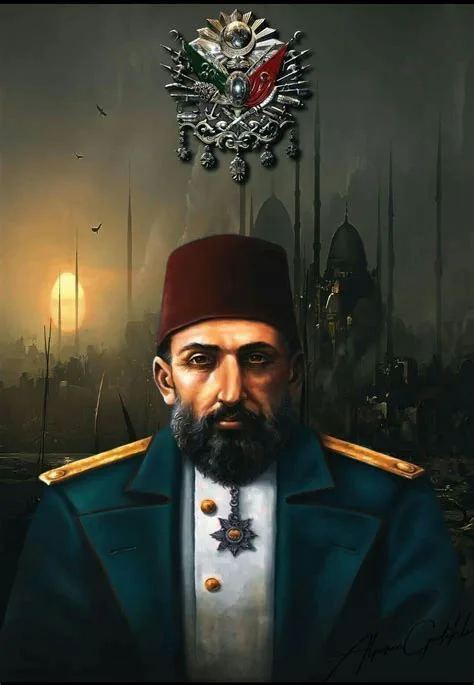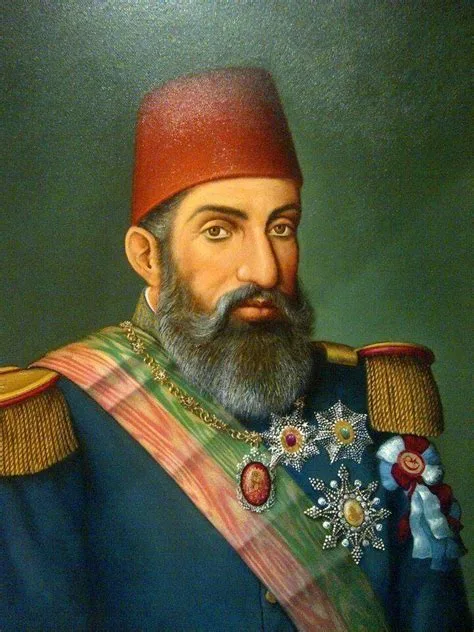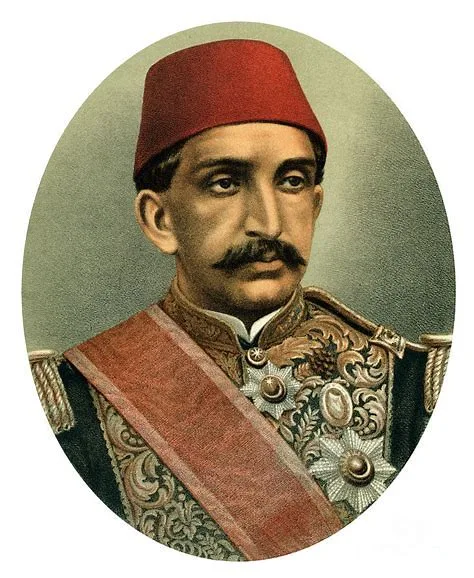Table of Contents

Who was Sultan Abdul-Hamid Khan?
Ruler Abdul-Hamid II was the 34th King of the Ottoman Domain, ruling from 1876 to 1909. He was the last Ruler to apply successful command over the cracking state. His rule was set apart by critical occasions and difficulties,
-An intriguing historical record about the top one politician Influencers on the world and the great controversy European politics controller Ruler of Almighty Sultan Abdülhamid II, April,1,1893.He is is the one of from the top ability on worldwide political leaders .
Sultan Abdul-Hamid II is the greatest Ruler Sultan of the Sea and the best Ruler of Rumi,Arab,Rush,Halab,Qibti ,Egypt Bagdad, sham,Azerbaijan, khorasn, faris,Al Qudus, Hijaz of Meka and Medina.
His Highness the Fabulous Ruler Abdul-Hamid Khan was brought into the world on September 21, 1842 (16 Shaban 1258).He is the 34th sovereign of the Osman administration and the 28th since the triumph of Constantinople. He is the child of Ruler Abdul-Medjid Khan, who kicked the bucket on June 25, 1861.
He succeeded his sibling, Ruler Murad V, on August 31, 1876. For a considerable length of time on the high position, Abdul-Hamid has energetically worked, night and day, for the prosperity of his realm.
1-The first step of constitutional Changes
1.1-Restoration of the Constitution:
From the get-go in his rule, Abdul-Hamid II declared the principal Ottoman constitution in 1876, meaning to modernize the realm and avoid unfamiliar mediation.
1.1.2.First Protected Time (1876-1878):
– **Constitution of 1876**: Declared by Abdul-Hamid II, this was the primary constitution of the Ottoman Realm, affected by the Tanzimat changes.
The European elite tournament the presentation of modern Political movement ordering securely and started political tactics throughly in chains of youth generation to empower began the consistence of political activism. This thoughts develop in those who believe on really democracy reforms with Youthful movement in Ottomans empire and Europe.
It meant throughly the empire gradually pointed and poisoning by the master cruel offensive mainly using their political sytem to punishment and need modernize of Europe civilization Realmap and cutoff the King’s outright power. –
**Parliamentary System**: The constitution laid out a bicameral parliament, comprising of the Senate (designated by the King) and the Office of Representatives (chose by individuals).
– **Suspension**: In 1878, Abdul-Hamid II suspended the constitution and broke down the parliament, returning to imperious rule because of political shakiness and outer dangers.
1.1.3.Second Sacred Time (1908-1922):
It seems that you are referring to a major period in Ottoman history. The years 1908-1922 were a revolutionary period for the Ottoman Empire, marked by the transformation of the Young Turks, the Balkan Wars, the Second World War and the inevitable disintegration of the Empire. This period is often seen as a time of change, war and great change.Can you give a detailed overview of the important events and people of this period, or is there a particular point of view that you would like to explore more faithful companion
The Youthful Turk Transformation in 1908 constrained Abdul-Hamid II to reestablish the 1876 constitution and reconvene the parliament.
2-Political Reforms
Sultan Abdul-Hamid II’s handling of political change was sweeping and multifaceted, reflecting his desire to modernize the Ottoman Empire while maintaining dictatorial control. Here are some key elements of his political changes:
2.1.Centralization of Power
-Abdul-Hamid II centralized power, reducing the power of ordinary representatives and local pioneers. This decision was intended to create a more cohesive and controlled organization.
2 . 2-Constitutional Restoration:
First, Abdul-Hamid II suspended the Ottoman Constitution of 1876 and dissolved the Parliament. However, under pressure from the Young Turk Uprising in 1908, he had to restore the Constitution and revise the Parliament, marking the beginning of the Second Protected Period.
2.3-Government Modernization:
He rebuilt the police force on the Western model and created a pension fund for government employees. These changes were intended to modernize the administrative structures and work towards the efficiency of the state apparatus.
2.4-Educational reforms
Abdul-Hamid II invested in education to strengthen the state. He expanded the organization of schools and colleges, recalling the renovation of Istanbul College in 1900. These efforts aimed to make the organization more educated and stable.
2.5-Legal Reforms:
His Grand Vizier, Mehmed Said Paşa, led critical legal changes, including updating the legal code and legal framework to align more closely with European standards.
2.6-Pan-Islamism:
Strategically, Abdul-Hamid II established a pan-Islamic framework to unite the kingdom’s Muslim population and neutralize European expansionism.
This arrangement also strengthened his position as the caliph of Islam, thereby consolidating his position.These changes were important to Abdul-Hamid II’s broader strategy to modernize the Ottoman Empire while maintaining his absolutist rule .
Despite his efforts, his reign faced critical difficulties, including internal differences and external pressures, which eventually led to his abdication in 1909.Were there any special changes or events during his reign that you would like to learn more about
This period saw expanded political activism, the development of ideological groups, and more prominent public support in administration. – **End of Abdul-Hamid II’s Reign**: In 1909, Abdul-Hamid II was removed, and his sibling Mehmed V rose the high position. The Effect of Protected Changes:
– **Modernization Efforts**: The protected changes were essential for more extensive endeavors to modernize the Ottoman Realm, including instructive and managerial changes.
– **Political Activism**:The established periods empowered political activism and the development of new political developments, including the Youthful Turks.
– **Ethnic Tensions**: The changes likewise featured and some of the time exacerbated ethnic pressures inside the assorted realm. These sacred changes were significant in the late Ottoman Domain’s endeavors to adjust to the tensions of modernization and outside dangers, despite the fact that they at last couldn’t forestall the realm’s decay.
– **Dictatorial Rule**: In the wake of suspending the constitution in 1878, he managed imperiously, depending on an arrangement of mystery police, oversight, and an extended message organization.
3- Educational Reform And Skills Islamism:
He embraced a strategy of dish Islamism to reinforce his standard and rally Muslim help against Western intercession.Instructive change with regards to Islamism includes incorporating Islamic standards with current instructive practices to cultivate both otherworldly and scholarly development. Here are a few key viewpoints:
3.1. Holistic Education:
Islamic instruction underlines a comprehensive methodology, incorporating profound, moral, and scholarly turn of events. This is many times reflected in ideas like *tarbiyyah* (physical and scholarly turn of events), *ta’dīb* (moral and moral sustaining), and *ta’līm* (educating and learning).
3.2. Modernization and Adaptation:
In the advanced time, Islamic schooling has adjusted to incorporate contemporary subjects like science, innovation, and unknown dialects, close by conventional strict examinations. This assists understudies with being balanced and serious in a globalized world.
3.3.Role of Faith:
Training in Islam is viewed as a way to make both common progress and otherworldly satisfaction. The Quran and Hadith stress the significance of looking for information, with refrains like “Read! For the sake of your Master who made” (Quran 96:1) featuring the heavenly order to seek after schooling.
3.4.Educational Institutions:
Islamic instructive organizations, like madrasas, have generally been focuses of discovering that delivered researchers capable in different fields, including religious philosophy, reasoning, and science.
Current changes expect to restore this custom by incorporating Islamic qualities with contemporary instructive norms. These changes intend to make a reasonable school system that supports both the brain and the spirit.
The planning people to contribute decidedly to society while keeping up with their strict character Training Reforms, and he laid out various expert schools, extended essential and auxiliary training, and established the College of Istanbul in 1900,Clashes and Losses.
4-Economic Reforms
Ruler Abdul-Hamid II, who ruled from 1876 to 1909, executed a few critical monetary changes in the Ottoman Domain. Here are a few key perspectives:
4.1.Railway Construction:
One of the most prominent accomplishments was the development of the railroad organization. The development of railroads in Asia Minor and Syria, frequently with unfamiliar capital, further developed transportation and exchange inside the realm.
The Hejaz Rail route, which associated Damascus to Medina, was especially huge and was supported by gifts from Muslims around the world.
4.2.Austerity Measures:
Abdul-Hamid II embraced somberness strategies to lessen state costs. This included chopping down castle consumptions, decreasing the compensations of rulers and authorities, and putting the royal residence’s costs under the confidential depository as opposed to the state depository.
4.3.Financial Oversight:
The spending plan was set under the management of a monetary change panel prior to being introduced to the Board of Priests. This move meant to guarantee better monetary administration and responsibility.
4.4.Legal and Instructive Reforms:
Financial advancement was additionally upheld by lawful changes drove by his excellent vizier, Mehmed Said Paşa, and enhancements in schooling, for example, the remodel of Istanbul College in 1900. These changes were important for Abdul-Hamid’s more extensive technique to incorporate power and modernize the realm, in spite of the difficulties and resistance he looked during his rule.
5-Secured and protect Empire Territories
The Muslim Calipha or Padisha Abdul-Hamid II used several methods to seize and protect the regions of the Ottoman Empire during his reign from 1876 to 1909:
5.1-Pan-Islamism:
Abdul-Hamid II used religious Islamism to strengthen his position. internally and to stimulate Muslim support within and outside the kingdom. This approach created a sense of solidarity among the kingdom’s diverse populations and caused problems for European powers with Muslim colonies.
5.2-Diplomacy:
Exercised a careful diplomacy to maintain the kingdom’s influence and explore relations with major world powers. This included alliances with Germany, England, and France to prevent a single power from ruling Ottoman affairs.
5.3 .Military and Infrastructure:
Abdul-Hamid II invested resources in military reforms and infrastructure projects. He expanded the organization of the messengers, which further developed communication throughout the domain, and assembled the Hejaz Railway, which not only operated. with movements in the blessed urban areas of Mecca and Medina, but also strengthened the kingdom’s control over its regions of the Middle East.
5.4 .Education and Modernization:
He focused on modernizing the field through educational changes. He established various vocational schools, expanded compulsory and optional education, and founded Istanbul University. These efforts aimed to create a more educated and determined people.
5.5-Secret Police and Censorship:
To maintain control and suppress dissent, Abdul-Hamid II relied on a system of secret police and strict surveillance. This allowed him to monitor and control any internal danger weighing on him.These actions generally help the sultan padisha Abdul-Hamid II to maintain command of the Ottoman kingdom at a time of critical internal and external difficulties.
6-Restored Military foundation
Sultan Abdul-Hamid II made great efforts to strengthen and modernize the tactical bases of the Ottoman Empire. Here are some of the main methodologies he used:
6.1-Military Reforms:

Abdul-Hamid II continued the tactical changes initiated by his predecessors. He focused on modernizing the army by adopting European military procedures and advances. This included new training techniques, armaments, and military unification.
6.2 .Creation of military schools:
He established several military schools to prepare officers and warriors for actual combat. These institutions hoped to produce a new generation of competent and determined military forces.
6.3-Infrastructure development:
Abdul-Hamid II invested resources in foundation projects that supported planned military operations. The development of the Hejaz Railway, for example, allowed for the development of troops and supply lines, especially at the peak of the Middle East.
6.4 -Strengthen the Navy:
Aware of the importance of naval power, he gradually strengthened the Ottoman naval force. This included the purchase of new ships and naval training and office work.
6.5 -Centralization of Command:
Unified military command to ensure better coordination and control. This helped to smooth the dynamic cycles and work towards the overall effectiveness of the army.
6.6-Using current technology:
Abdul-Hamid II was enthusiastic about integrating modern innovation into the army. This included the use of broadcasts for the correspondence and display of modern artillery and cannons.These efforts were central to Abdul-Hamid II’s broader system of strengthening Ottoman rule and maintaining its regional credibility at a time of great internal and external challenges.
7-How could be fall dawn The Ottoman Empire?
The inevitable decline and fall of the Ottoman Empire was the result of a complex interaction influenced by various variables over several centuries. Here are seven main reasons that contributed to its fall:
7.1-Military losses:
The Ottoman Empire faced heavy military losses, especially in the 17th and 18th centuries. The incomparable Turkish War (1683-1699) weakened its tactical power and regional control.
7.2-Economic Decline:
The kingdom’s economy suffered from a lack of shipping routes, rivalry between European powers, and internal degradation. The discovery of new sea routes by European adventurers diverted trade away from the Ottoman-controlled Silk Road.
7.3-Administrative Inefficiency:
The size of the domain made management difficult. Degradation, nepotism, and a failure in the management system led to mismanagement and a weakening of central authority.
7.4-Technological lag:
The Ottomans were slow to adopt new military and modern innovations compared to European powers. This innovation gap made military and monetary warfare difficult issue becomesin regional policies hardly to control.
7.5-Nationalism and Autonomy Movements:
The rise of patriotism in the 19th century spurred pro-liberty developments in this area. Various ethnic and religious groups demanded independence or freedom, which led to internal conflicts and divisions.
7.6-External Pressures:
European powers such as England, France, and Russia placed critical strains on Ottoman rule through military conflicts, political movements, and monetary rivalries. The kingdom’s substantial size made it a target for these powers.
7.7-World War:
The Ottoman Empire’s alliance with the Central Powers in World War II led to its ultimate collapse. The defeat of the Central Powers and the Treaty of Sèvres in 1920 destroyed the Ottoman dominions, leading to the creation of present-day Turkey and other nation-states in the region.These variables, among others, generally contributed to the eventual decline and dissolution of the Ottoman dominion . If you have a particular point of view that you would like to explore further, please feel free to ask!
His rule saw the deficiency of regions like Egypt and Cyprus, and he confronted huge uprisings and wars, including the Russo-Turkish Conflict (1877-78). Abdul-Hamid II’s standard finished in 1909 when he was removed and prevailed by his sibling, Mehmed V..
Nothing has been failed to genuinely foster government funded schooling, business, and particularly rail lines. For quite a long time, Abdul-Hamid, through his wise and wary strategies, has figured out how to stay away from a few expected clashes with Europe.
Summary
He has reliably executed every one of the provisions of the Settlement of Berlin, which stays unenforced in the angles that could be profitable for his country.In suburbia of Constantinople, where nature appears to delight in making fantasy scenes exceptional on the planet, it would have been difficult to pick a superior area.
From the windows of the structure that stands on the slope where the Janissaries once prepared, one can shift focus over to the right at the blue waters of the Ocean of Marmara and extend one’s look to the left toward the pinnacles of the two Hissars. Abdul-Hamid ascends at five AM.
When he gets up, he washes up and rehearses hydrotherapy widely — another type of ablutions . The sultan then starts his typical working day by inspecting the principal European and Turkish papers. At the point when an article grabs his eye, he peruses it cautiously and makes notes on his appearance.
Around ten o’clock, the sovereign gathers his chamberlains, those depended with his certainty. Haji Ali Bey, who has broad information on potential topics that populaces of Focal Asia, and Emin Bey, who is conversant in European dialects, have been in favor for a considerable length of time.
With respect to harmony, Abdul-Hamid is without a doubt quite possibly of its most talented promoter not on the grounds that his military permits him to force his will in Europe, but since, through his tact.
He has tackled the difficult issue of cupable none of the people who look after his European belongings to not side of him and particularly, they use the Bosphorus waterway. His Royal Grandness can be guaranteed that France harbors no aggressive plans on Turkey and, in actuality, remains its ideal and most faithful companion.

Your article helped me a lot, is there any more related content? Thanks!
thanks
Thanks for sharing. I read many of your blog posts, cool, your blog is very good.
Thanks for your suggestions
Thank you for your sharing. I am worried that I lack creative ideas. It is your article that makes me full of hope. Thank you. But, I have a question, can you help me?
Ask what’s you need
I don’t think the title of your article matches the content lol. Just kidding, mainly because I had some doubts after reading the article.
For more information read more reverence
he is the most powerfull sultan
Can you be more specific about the content of your article? After reading it, I still have some doubts. Hope you can help me.
Ready more historical